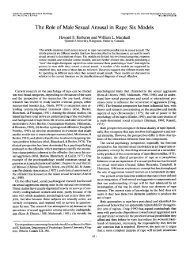Regulation of the dopamine transporter - Addiction Research ...
Regulation of the dopamine transporter - Addiction Research ...
Regulation of the dopamine transporter - Addiction Research ...
Create successful ePaper yourself
Turn your PDF publications into a flip-book with our unique Google optimized e-Paper software.
Schmitt & Reith DAT <strong>Regulation</strong><br />
DAT-lacking animals. In particular, cocaine’s interaction<br />
with <strong>the</strong> serotonin <strong>transporter</strong> (SERT)<br />
has been hypo<strong>the</strong>sized to contribute to continued<br />
self-administration in DAT-knockout animals. 7,8<br />
Never<strong>the</strong>less, convincing preclinical evidence implicating<br />
specific activity at <strong>the</strong> DAT in cocaine dependence<br />
comes from <strong>the</strong> observation that <strong>the</strong> reinforcing<br />
effect <strong>of</strong> cocaine is lost in transgenic mice<br />
expressing a triple point–mutated DAT with preserved<br />
(albeit somewhat reduced) substrate translocation<br />
but little appreciable affinity for cocaine. 9<br />
It is conceivable that elevated basal <strong>dopamine</strong>rgic<br />
tone in <strong>the</strong>se mice (a result <strong>of</strong> <strong>the</strong>ir reducedfunction<br />
DAT is<strong>of</strong>orm) causes adaptive changes,<br />
altering <strong>the</strong> response to cocaine; however, knockdown<br />
mutant mice with a ∼90% reduction in<br />
DAT expression—but with functionally unmodified<br />
DATs and elevated basal <strong>dopamine</strong>—still exhibit robust,<br />
wild-type–like preference for cocaine, indicating<br />
that interaction with <strong>the</strong> DAT is necessary for<br />
<strong>the</strong> reinforcing effects <strong>of</strong> cocaine in animals that<br />
carry <strong>the</strong> DAT. 10 Moreover, a recent investigation<br />
by Thomsen et al. showed that a different strain<br />
<strong>of</strong> DAT –/– (DAT knockout) mice generally fail to<br />
acquire intravenous cocaine self-administration behavior.<br />
11 Importantly, in <strong>the</strong> minority <strong>of</strong> mice that<br />
do initially show self-administration, this behavior<br />
is quickly extinguished as <strong>the</strong> response requirement<br />
(<strong>the</strong> “work” required to obtain a dose <strong>of</strong> cocaine) is<br />
increased. In contrast, both wild-type and SERT –/–<br />
mice maintain consistent self-administration, even<br />
when <strong>the</strong> response requirement for a single dose <strong>of</strong><br />
intravenous cocaine is increased 50- to 100-fold. Unlike<br />
cocaine, o<strong>the</strong>r <strong>dopamine</strong>rgic compounds (i.e.,<br />
<strong>the</strong> <strong>dopamine</strong> D1-like receptor agonist SKF82958)<br />
and food rewards are comparably administered by<br />
DAT –/– and wild-type mice, indicating that elimination<br />
<strong>of</strong> <strong>the</strong> DAT does not globally hinder behavioral<br />
reinforcement. These data strongly suggest that cocaine<br />
is not a reliable reinforcer in <strong>the</strong> absence <strong>of</strong> <strong>the</strong><br />
DAT, despite some intersubject differences in initial<br />
responses among DAT –/– mice. 11<br />
The DAT governs both <strong>the</strong> duration and magnitude<br />
<strong>of</strong> <strong>dopamine</strong>rgic neurotransmission by actively<br />
translocating <strong>dopamine</strong> from <strong>the</strong> extracellular space<br />
into presynaptic neurons. Extracellular <strong>dopamine</strong> is<br />
also subject to enzymatic catabolism—thus terminating<br />
its signaling potential—however, studies <strong>of</strong><br />
DAT-knockout mice 6,12 have demonstrated that <strong>the</strong><br />
DAT is <strong>the</strong> chief arbiter <strong>of</strong> <strong>dopamine</strong>rgic signal-<br />
ing flux (for review, see Gainetdinov and Caron 3 ).<br />
Dopaminergic transmission is volume transmission<br />
with an extrasynaptic predominance <strong>of</strong> <strong>dopamine</strong><br />
receptors and <strong>transporter</strong>s; <strong>the</strong> function <strong>of</strong> <strong>the</strong> DAT<br />
is not to remove <strong>dopamine</strong> from <strong>the</strong> synapse but<br />
ra<strong>the</strong>r to regulate <strong>dopamine</strong>’s action at extrasynaptic<br />
<strong>dopamine</strong> receptors (see Rice and Cragg 13 for<br />
review and highly recommended, updated cartoon<br />
<strong>of</strong> a <strong>dopamine</strong> synapse). The overall rate <strong>of</strong> de novo<br />
DAT protein syn<strong>the</strong>sis is a relatively slow process—<br />
<strong>the</strong> half-life <strong>of</strong> striatal <strong>transporter</strong> proteins, for example,<br />
is approximately 2–3 days. 14,15 Hence, it is<br />
not surprising that cells use an assortment <strong>of</strong> posttranslational<br />
regulatory strategies to rapidly alter<br />
DAT function—without requiring de novo protein<br />
syn<strong>the</strong>sis or transcriptional-level modifications—to<br />
dynamically shift <strong>the</strong> tone <strong>of</strong> <strong>dopamine</strong>rgic activity<br />
in response to various endogenous and exogenous<br />
stimuli. There are two conceivable manners<br />
in which a cell could modulate DAT function “on<br />
<strong>the</strong> fly” (on a time scale <strong>of</strong> seconds to minutes) in<br />
response to changing environmental conditions—<br />
ei<strong>the</strong>r via direct modification <strong>of</strong> single-<strong>transporter</strong><br />
parameters, such as intrinsic substrate permeation<br />
efficacy, or by affecting <strong>the</strong> trafficking <strong>of</strong> <strong>the</strong> <strong>transporter</strong>,<br />
redistributing DATs between <strong>the</strong> plasma<br />
membrane and intracellular endosomal compartments.<br />
4 Experimental evidence has demonstrated<br />
that both processes may play some role in acute DAT<br />
regulation, but that redistribution <strong>of</strong> <strong>transporter</strong>s<br />
to and from <strong>the</strong> cell surface is <strong>the</strong> predominant<br />
mechanism. 16,17<br />
This regulatory method—rapid insertion or removal<br />
<strong>of</strong> plasmalemmal <strong>transporter</strong> proteins—may<br />
seem like a cumbersome way <strong>of</strong> acutely controlling<br />
neurotransmitter signaling; however, it makes logistical<br />
sense when we consider <strong>the</strong> kinetics <strong>of</strong> <strong>the</strong><br />
substrate translocation cycle. That is, <strong>transporter</strong>s<br />
must undergo a conformational shift between <strong>the</strong><br />
discrete phases <strong>of</strong> extracellular substrate binding<br />
(outward facing) and cytosolic substrate release (inward<br />
facing), limiting <strong>the</strong> potential maximum uptake<br />
velocity to around one substrate molecule per<br />
second per <strong>transporter</strong>. 4 Ion channels, by contrast,<br />
can achieve flux velocities on <strong>the</strong> order <strong>of</strong> millions <strong>of</strong><br />
ions per second per channel. 18 Because <strong>the</strong>y <strong>of</strong>fer a<br />
far wider dynamic range in “substrate” flux rate, ion<br />
channels are more amenable to regulation strategies<br />
involving posttranslational modification at <strong>the</strong> individual<br />
protein level than <strong>transporter</strong>s, such as <strong>the</strong><br />
Ann. N.Y. Acad. Sci. 1187 (2010) 316–340 c○ 2010 New York Academy <strong>of</strong> Sciences. 317










